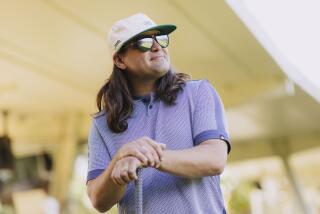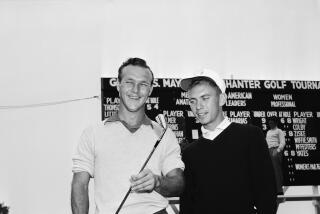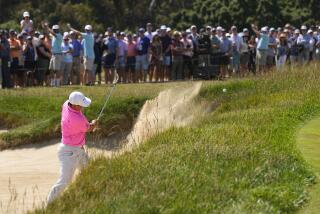O’Meara the Pro in Pro-Am
- Share via
INDIAN WELLS — Golf is a crazy game.
Look, a Cy Young pitcher doesn’t arrive in the dugout before a league game to be greeted by a guy with a wide smile and an unfamiliar face who sticks his hand out and says, “Hi! I’m Alvin Dork, the stock broker. I’m your partner today. How do we pitch to these guys?”
A Pro Bowl quarterback doesn’t show up for a playoff game to find himself suiting up next to a stranger in the next locker stall who says, “Hello there, Boomer! I’m Dr. Clyde Andrews, eye, ear, nose and throat. We’re paired up here today. I’ll try to get open in the flat but, frankly, I haven’t played much lately so don’t expect too much.”
The Chicago Bulls don’t take the court and suddenly a guy comes running up to Michael Jordan, pulling his tie and shirt off as he says, “Hello there, Michael. I’m Irving Glass, I’m in the export-import business, but we’re playing together today. I’ll try to help you post up on these guys, I’ve been working on the give-and-go. Let’s take it to Shaq!”
Those things don’t happen in other sports, but in golf they happen all the time. The Bob Hope Chrysler Classic golf tournament is a case in point, the lodestone of the genre. It’s a fantasy camp for corporate and entertainment America. It’s a chance for the weekend hacker to realize his dreams--play a round with an Arnold Palmer, Jack Nicklaus, Tom Kite or Billy Casper. He could never get to play center field with Joe DiMaggio or hit behind Henry Aaron but he’s on a putting green with the immortals of the golf world.
The pro-am concept was invented by Bing Crosby back in the ‘30s. Bing just wanted to tee it up with the pros, his idols. Bing was a frustrated pro himself, and out of this evolved the staple of the golf tour, the pro-am.
It beat getting autographs for Bing and out of it he also blueprinted the idea that the monies the rich posted to play in these things go to charity. Almost every tournament today has a pro-am, but they are one-day events. The Hope is the ultimate fruition of the idea, you pay to play four days with the registered giants of the game.
This format practically built the magnificent Eisenhower Medical Center and it funds it annually with almost a million dollars.
If it was good for charity, it was also good for golf. TV viewers who didn’t know a putt from a punt were enticed into watching the sport when movie stars, sports stars and the firmament of the business world frolicked in the sun while most of the rest of the country was up to its rooftops in snow.
It outpolled even venerable tournaments in ratings and contributed mightily to the growth of golf. The winner’s take in 1961 was $5,300. Last year, it was $234,000.
Despite such spectacular evidences of its correctness, it has not always been the favorite event of the pros. Golf is not a team game. It is almost the last stand of the rugged individualist in this country. It’s you against the course, you against the world. Some pros can’t bear to look when their pro-am “partner” swings at the ball. Afraid it might be catching.
But it put the game in the forefront the way the B.C.-En Joie or the Deposit Guaranty Classic never could.
Mark O’Meara is a star player on today’s tour. With a gorgeous right-to-left swing, the sunny disposition of a guy who always expects the next card to be an ace, he has the perfect temperament for a guy who makes his living putting.
O’Meara has been so successful at the pro-am format he is known on tour as the King Of The Pro-Ams. Of the 12 tournaments he’s won, five have come in the multi-round pro-am format. He has won the AT&T; (nee, the Crosby) four times. He won the Walt Disney World in 1991. In the Hope, he was in a playoff for the title twice. “Mark plays best surrounded by 14-handicappers,” Gary McCord joked.
If it’s eerie how successful he’s been, Mark thinks he knows why. “It has a lot to do with my personality. Look, I come from a long line of people who were in sales. My father was in sales. I would be if I didn’t make it in the PGA.
“So I’m not the type to walk down a fairway glowering. I’m not the type to walk down and not talk to anybody, smile at anybody. Just because a guy you’re playing with can’t hit a golf ball well, that doesn’t make him a bad human being.”
O’Meara admits he can see where the problem arises. “You wait around a lot when you play with someone who takes the long way to the hole, and you play with people who reach in their bag for an old ball when they come to a water hole. You have to wait between shots and some guys get upset because they think their rhythm gets disturbed.
“You look at it this way: Last week, you played a round of golf in three hours and 20 minutes. This week it takes you five hours and 20 minutes. You play behind Mr. Hope and President Ford, as I did Friday, and you have the Chrysler girls running across the green and they’re doing everything but taking the balloons down and the crowds scatter. They did that three holes in a row. You can’t have Chrysler girls running across a green when you’re getting ready to shoot. Now, I like pretty girls as much as the next guy--but not in my line.
“But I understand. Other pros take the position that’s our office out there and we’re doing business.”
Well, true. Of course, at Yankee Stadium they throw batteries at you. At Dodger Stadium two years ago, they threw baseballs. In most sports, players perform on the road to a torrent of abuse. People wave balloons in your face at the free-throw line in basketball. Fans interfere with balls in flight in pennant playoffs. In golf, after all, no one throws at your head or blindsides you with a crack-back block on the tee.
The occasional Chrysler girl sprinting across your line would seem a small price to pay.
O’Meara, as usual, managed to ignore the distractions enough to shoot his way to a 20-under score, fourth on the leader board down here as the tournament goes into its final day.
And it was O’Meara who was chosen to present Bob Hope with the humanitarian award the PGA Tour bestowed on him for his many services to golf and humanity.
O’Meara said he was proud to do it. “This was the first tournament I played in. They gave me a sponsor’s exemption. I would have played with Attila the Hun, Benedict Arnold and Morgan the Pirate. I still would.”
More to Read
Go beyond the scoreboard
Get the latest on L.A.'s teams in the daily Sports Report newsletter.
You may occasionally receive promotional content from the Los Angeles Times.










